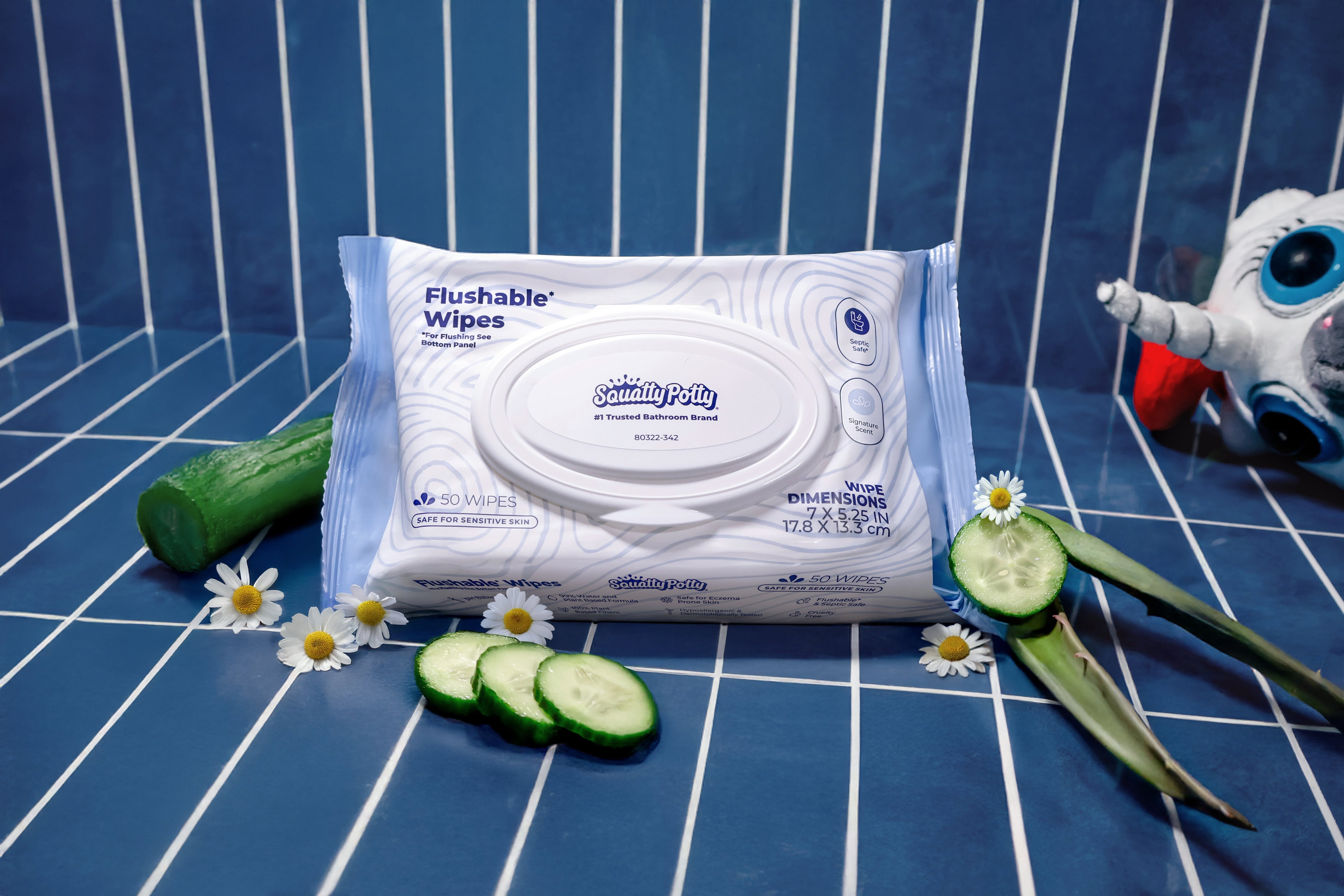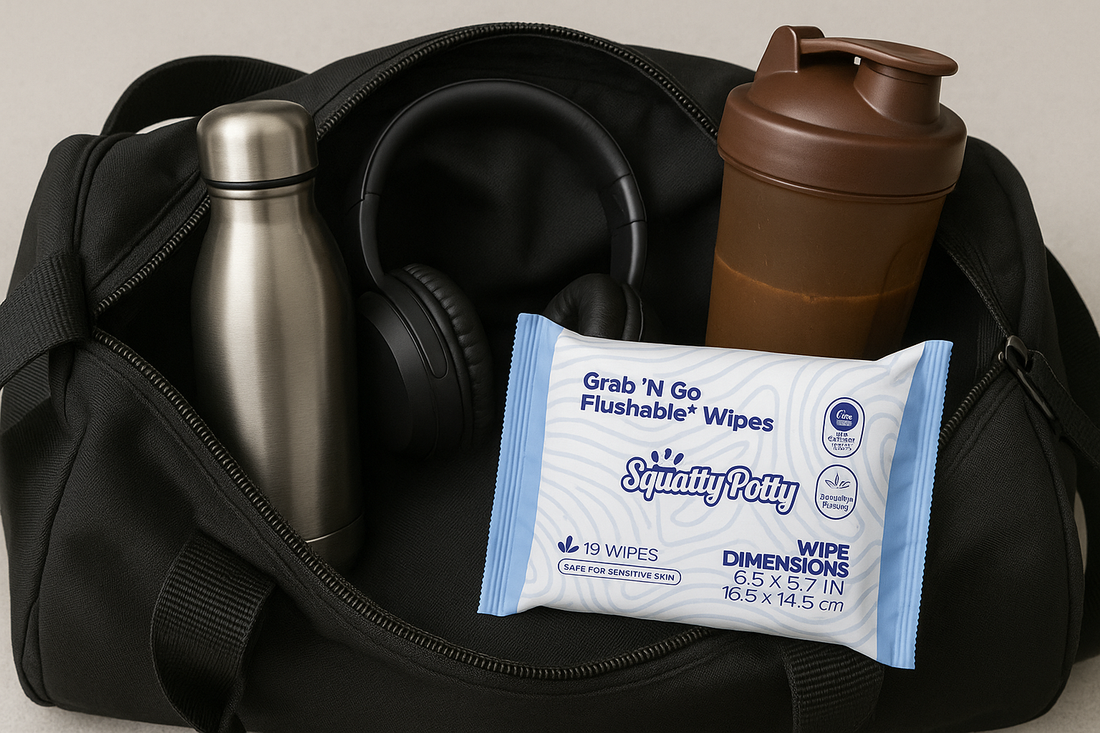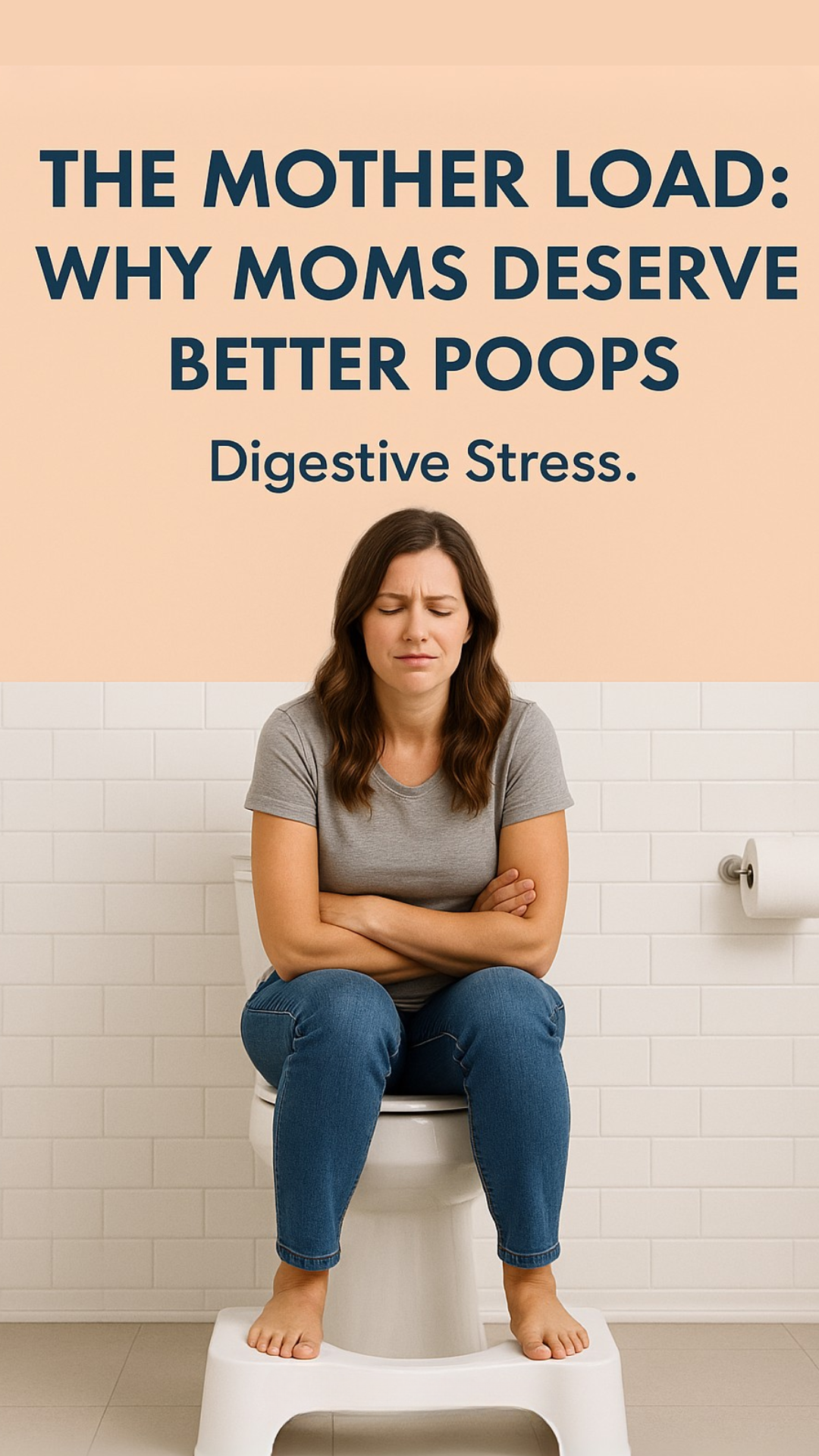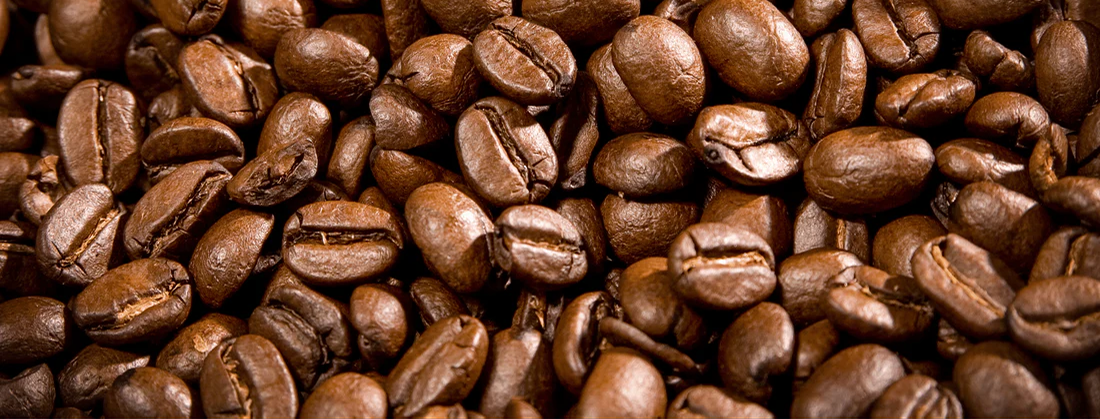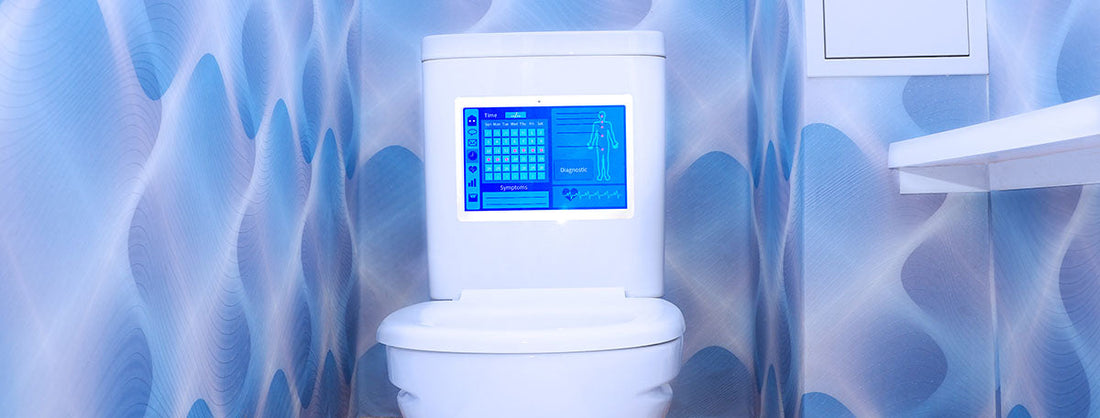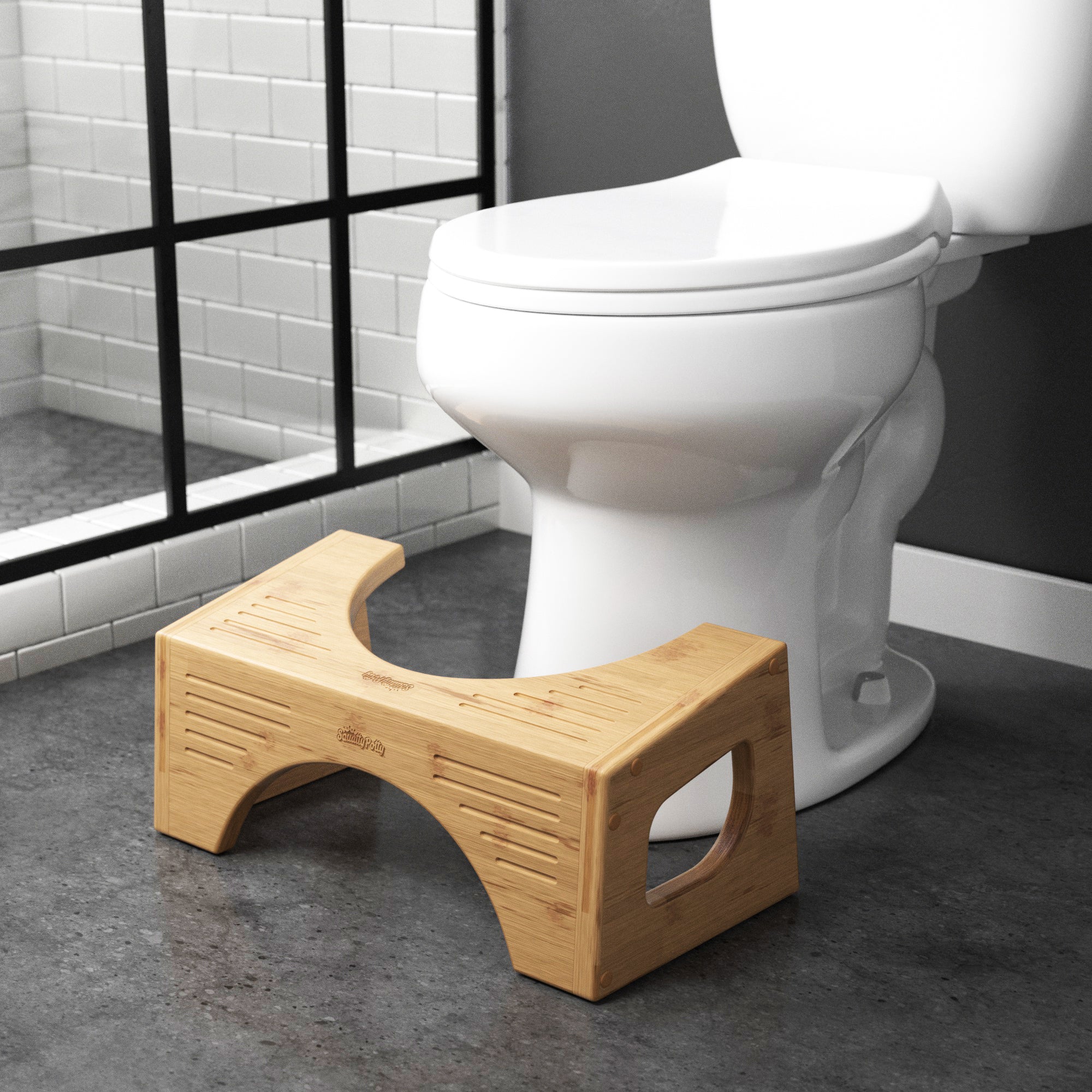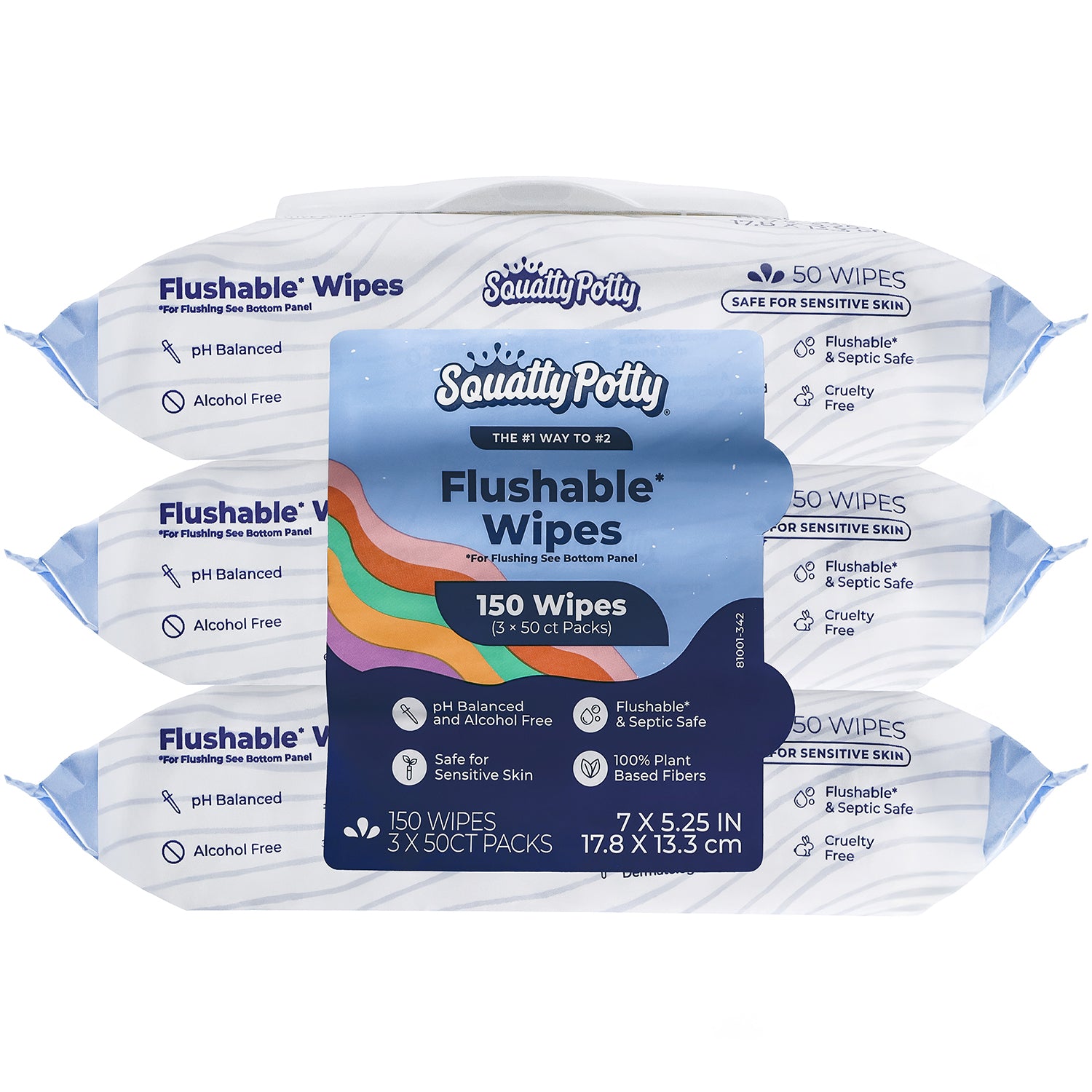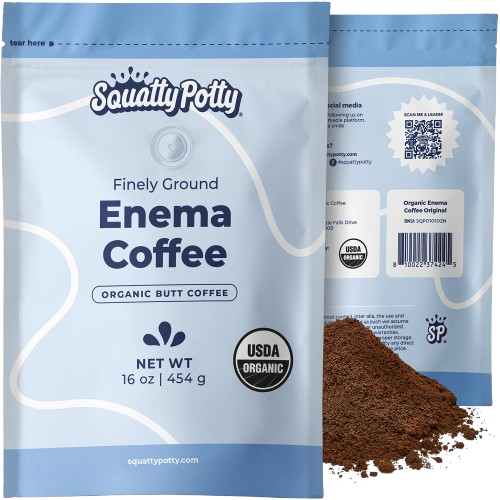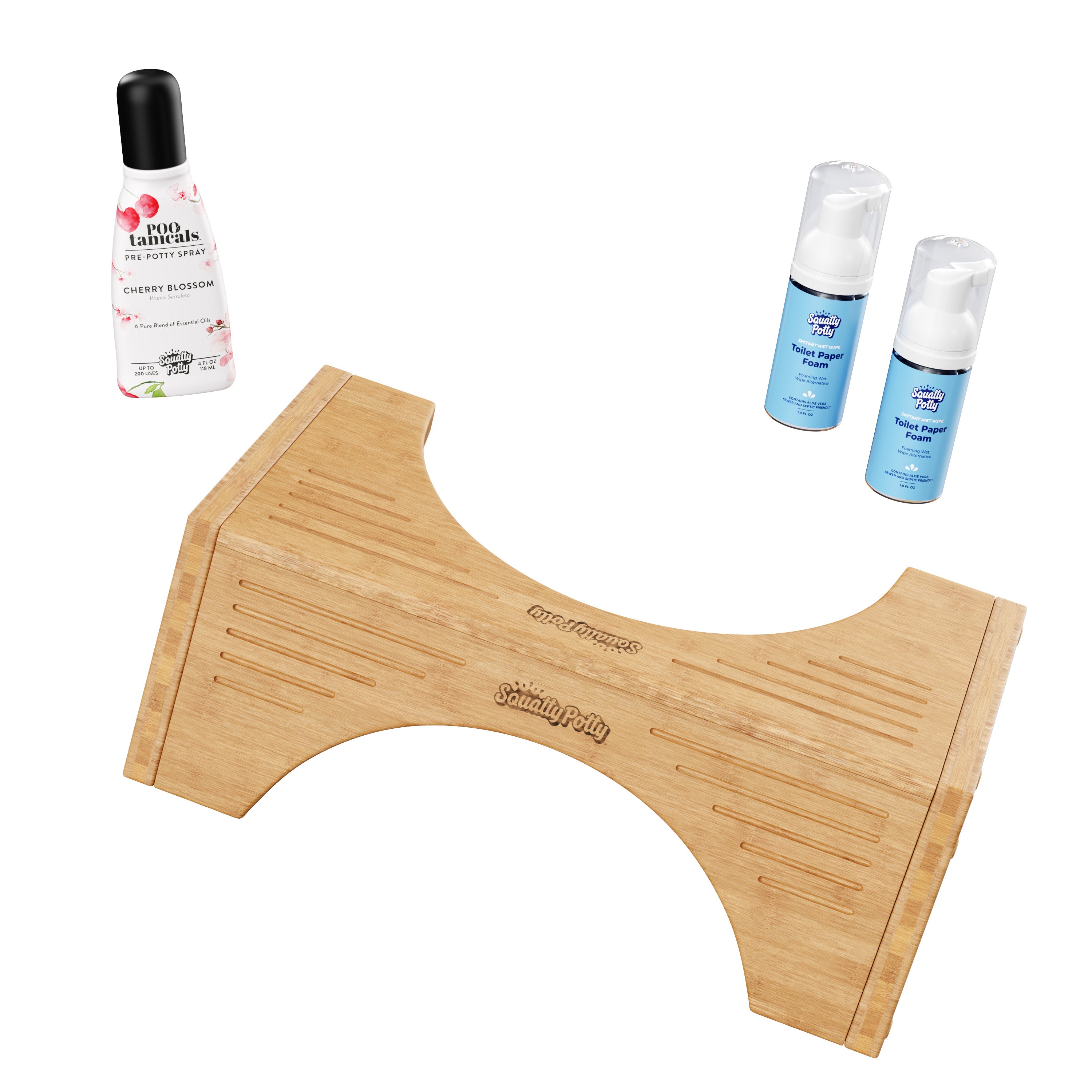Blog
Road Trips & Rest Stops: Clean Comfort on the Go
There’s something magical about the open road - scenic views, playlists, snacks, and new destinations on the horizon. But let’s face it: one thing most travelers dread is the rest stop bathroom. Cramped stalls, questionable cleanliness, and minimal supplies can leave you feeling less than fresh after a pit stop. But, you can beat those bathroom blues with some minor preparation and a few essentials, like our Squatty Potty Grab N’ Go Flushable Wipes, to help you feel clean and fresh for the next leg of your journey. Why Road Bathrooms Pose Skin & Hygiene Challenges Traveling presents a unique set of stressors for your skin and body: High Germ Load: Public restrooms harbor lots of bacteria and pathogens on surfaces and in air droplets. Studies show that toilet flushing aerosolizes droplets that can carry microorganisms into the air. (Schreck et al., 2021) (https://arxiv.org/abs/2101.11990) Sweat + Friction = Trouble: On a long drive, you’re often in the same shorts or pants for hours. As body temperature rises, sweat accumulates, magnifying friction in zones like thighs, groin, or under gear. Damp, rubbing skin is a recipe for chafing, irritation, or even superficial inflammation. Ineffective Cleaning: If you are trying to get clean with thin, rough toilet paper or with just whatever small amount is left on the roll, you risk leaving residue and moisture behind that can lead to itching or discomfort later. Inconsistent Supply: There’s no guarantee that a rest stop bathroom will or will not have, so being self sufficient is crucial in those moments when there’s not a Given those factors, road-trip hygiene can become more just trying to get as clean as possible as opposed to feeling comfortable. Tips for Staying Fresh & Protected During Travel Here are recommendations based on skin science and practical experience: 1. Build a Compact Travel Hygiene Kit Make a small pouch with essentials like: Hypoallergenic wipes A folded piece of toilet paper or portable “emergency roll” Travel-size hand sanitizer (60%+ alcohol) A mini spray bottle or squeeze bottle (for water rinse) A compact microfiber towel or soft cloth A spare pair of undergarments By carrying your own kit, you avoid relying entirely on rest-stop supplies. 2. Prioritize Gentle Cleaning, Not Aggressive Scrubbing In delicate skin zones, friction can do more harm than good. Use a gentle wipe or moistened cloth to lift residue efficiently and effectively rather than scrubbing intensely with dry paper. 3. Always Pat Dry After Wiping After you wipe or clean, always pat (don’t rub) the area dry with clean tissue or a soft cloth. This avoids residual dampness, which, as noted, can encourage irritation or microbial overgrowth. 4. Change & Air Out Underlayers Whenever possible, switch to fresh underwear or liners. Even a 5-minute break can reduce skin temperature and let moisture evaporate, cutting friction risk. 5. Mind Friction Hot Spots Areas to watch: thighs, groin folds, anywhere your clothes or straps rub. Use your wipes or water to keep these zones clean and dry. Use light powders or cloth barriers if you’re prone to chafing. 6. Sanitize High-Touch Surfaces Wipe down stall surfaces (door handles, flush handles, latch handles) with a disinfectant or your wipes before touching. This limits your exposure to germs. (Health.com covers how public restrooms harbor microbes and aerosol contamination) 7. Limit Time in the Stall The longer you’re in a humid, enclosed restroom, the more aerosolized microbes linger in the air. Get in, do your business, clean, dry, and exit—don’t linger. The Schreck et al. (2021) aerosol study backs this; more flushes and more time means more aerosol buildup. How Squatty Potty Flushable Wipes Fit Into the Road-Trip Strategy Squatty Potty Flushable Wipes are the perfect travel companion for any road warrior. While developing our wipes, we learned what works and what doesn’t when it comes to effective cleaning, from moisture level to targeted ingredients. Here’s how our wipes address the tough constraints of on-the-go hygiene: Gentle but effective: 99% water, alcohol-free, no parabens or dyes—so they cleanse without harsh chemicals. Dermatologist-tested & pH-balanced: Built to respect sensitive and eczema prone skin. Botanical comfort: Infused with soothing aloe, chamomile, green tea, and a touch of witch hazel to help sooth and leave you feeling fresh. Strong yet soft plant-based fibers: 100% plant based fibers are strong enough to clean, while minimizing friction. Flushable & septic-safe: Engineered to disperse when flushed when you follow the flushing guidelines on the packaging. Balanced Moisture: Wet enough to effectively clean without excess moisture left behind. Portable formats: Compact sizes including a Grab ‘N Go 18-count, a full size 50-count, and multi pack configurations for stocking up in preparation for longer trips. This makes them easy to stash in your glove box, travel bag, or console. To put it simply, these wipes don’t just feel great, they’re built to handle the real-world challenges of travel hygiene. Final Word Road trips should be about fun and discovery - not being preoccupied with bathroom anxiety or post pit stop discomfort. With the right strategy (cleaning gently, drying thoroughly, swapping damp layers) and the right tools in hand, you can stay fresh mile after mile. So be prepared with a dependable, skin-friendly wipe you trust - one that pampers your skin, is easy to pack, and helps you feel good from start to finish. Squatty Potty Flushable Wipes make every bathroom break feel fresh and effortless — no matter where you go!
Learn moreGym Bag MVP: How to Freshen Up Mid-Workout - And Why It Matters
Read about how using Squatty Potty Wipes as a mid-workout hygiene tool just makes sense.
Learn moreThe Mother Load: Why Moms Deserve Better Poops
Let’s be honest: moms carry a lot. They carry the mental load. The emotional load. The diaper bag. The group chat. Sometimes even actual humans on their hips. But you know what else moms carry—quietly, heroically, and often with clenched teeth? Digestive stress. From pregnancy-related constipation to postpartum recovery, hormonal changes to hectic schedules, moms aren’t just superheroes—they’re super poopers (or trying to be, anyway). And if anyone deserves better gut health and more bathroom relief, it’s them. The Gut Health Struggle Is Real (Especially for Moms) The female digestive system is sensitive to stress, hormonal shifts, and physical strain—all of which are regular parts of motherhood. Many moms experience constipation during pregnancy, postpartum digestive issues, and increased strain on the pelvic floor. Here’s the kicker: most don’t even realize how much better their bathroom habits could be—just by adjusting their posture. That’s where the Squatty Potty bathroom stool comes in. Why Squatty Potty Is the Best Gift for Moms’ Digestive Health A toilet stool might sound like a funny Mother’s Day gift idea—but the results are no joke. The Squatty Potty is a doctor-recommended tool that: Improves elimination posture Reduces straining and bloating Supports pelvic floor recovery—especially after birth or surgery Promotes regularity and gut comfort Whether she’s a new mom, seasoned pro, or self-care queen, this is a Mother’s Day gift for mom that keeps on giving. From our stylish bamboo toilet stools to our kid-friendly training options, Squatty Potty fits right into any bathroom (and routine). Don’t Just Send Flowers. Send Relief. This year, go beyond the basics. Our Mother's Day Gift Guide is full of wellness essentials and cheeky comforts that say “I love you” and “I want you to poop better.” ✅ Thoughtful ✅ Health-forward ✅ Actually useful Because flowers wilt. Candles burn out. But gut health? That’s a gift that lasts.
Learn more💘 The Gift of Sweet Relief
Valentine’s Day is all about love, romance, and thoughtful gifts. But let’s be real—nothing kills the mood faster than an uncomfortable trip to the bathroom. Whether you’re wooing a new flame or keeping the spark alive in a long-term relationship, there’s one thing every couple can agree on: gut health matters. Ditch the Chocolates, Give the Gift of Smooth Moves Forget the predictable box of chocolates that might lead to regret later. This year, show your sweetheart you care about their comfort with a Squatty Potty! Our Sweetheart Bundles make the perfect practical yet playful Valentine’s Day gift. Because nothing says “I love you” like a happier, healthier bathroom experience. Why Squatty Potty is the Ultimate Love Language 💖 Acts of Service: Help your partner enjoy effortless, strain-free poops. 💝 Quality Time: Less time struggling in the bathroom = more time together. 😂 Laughter: Because gifting a Squatty Potty is also a great way to say, “I love you and your digestive health.” Couples Who Poop Comfortably, Stay Together A recent (totally real) study* found that couples who use a Squatty Potty together are 100% happier. Okay, we made that up. But supporting your partner’s gut health is a real sign of love—and we all know that good digestion = a better mood.
Learn moreCoffee Enemas - The Ultimate Guide, Benefits, How-To, and Safety
The Comprehensive Guide to Coffee Enemas: Benefits, How-To, and Safety Coffee enemas have been a topic of interest in alternative health circles for some time. Proponents of coffee enemas claim various health benefits, from detoxification to improved mental clarity. If you’re curious about this type of colon cleanse, this guide will cover everything you need to know, including the potential benefits, how to perform one, and the associated risks. Coffee Enema Benefits: What is a Coffee Enema Good For? Detoxification: One of the primary reasons people turn to coffee enemas is for their supposed detoxification benefits. The use of coffee enemas is believed to stimulate the liver to produce more bile, aiding in the removal of toxins from the body. This detox process is said to enhance the body's natural cleansing processes, providing a cleaner internal environment. However, it's important to note that there is no scientific evidence to support the effectiveness of self-administered coffee enemas in completely detoxifying the body. Increased Energy: Some users report feeling more energized after a coffee enema. This effect is likely due to the absorption of caffeine through the colon and rectum, which can provide a temporary energy boost. Caffeine stimulates the central nervous system, leading to increased alertness and energy levels. Yet, relying on enemas for energy is not advisable without consulting a healthcare professional. Improved Mental Clarity: Many proponents of coffee enemas claim they lead to enhanced mental clarity and focus. By helping to detoxify the body, the colon and rectum may operate more efficiently, potentially translating to better cognitive function. However, the scientific evidence to support these claims is limited. Enhanced Digestion: Coffee enemas may help alleviate constipation and improve digestion by promoting bowel movements. They can stimulate peristalsis (the wave-like contractions in the intestines), which aids in moving waste through the digestive tract. While coffee enemas may relieve constipation, they should not be used as a regular remedy without medical advice. Antioxidant Properties: Coffee contains antioxidants like cafestol and kahweol, which help combat free radicals and reduce inflammation. These antioxidants may also provide protective benefits to the liver. Coffee enemas may thus contribute to overall health and well-being. However, there's limited evidence to suggest that coffee enemas are more effective than oral coffee consumption in healthy individuals. Why Coffee Designed for Enemas is Different from the Coffee You Drink Coffee used for enemas is distinct from the coffee you drink, and it’s crucial to understand these differences to ensure safety and effectiveness. 1. Purity and Organic Quality: Organic Coffee: Caffeinated coffee used for enemas is typically organic to avoid pesticides and chemical residues. Organic coffee ensures no harmful substances are introduced into the body through the enema. Purity: Coffee enema coffee is free from additives, flavors, and preservatives that are often found in regular drinking coffee. This purity is essential for reducing the risk of irritation in the colon and rectum. 2. Roast Level: Light Roast: Coffee for enemas is usually light roast, as it retains more of the natural compounds and antioxidants, such as palmitic acid, which are beneficial for detoxification. It has higher levels of caffeine and palmitic acid, stimulating the liver to produce bile. Drinking Coffee: Drinking coffee comes in various roast levels. Dark roast coffee has lower caffeine and palmitic acid content due to the longer roasting process, making it less effective for enema purposes. 3. Preparation and Cleanliness: Special Preparation: Coffee designed for enemas is processed and packaged to ensure it's free from contaminants and specifically labeled for enema use. Regular Coffee: Regular drinking coffee may contain oils, impurities, and other substances that can be harmful or irritating when introduced into the colon and rectum. 4. Caffeine Content: Higher Caffeine: Enema coffee typically has a higher caffeine content due to the light roasting process. Caffeine is crucial in stimulating the liver and promoting bile flow, which is essential for the detoxifying effects of the enema. Variable Caffeine: Drinking coffee varies widely in caffeine content depending on the beans and roasting process. Lower caffeine levels may not provide the same detox benefits when used in an enema. 5. Chemical Composition: Palmitic Acid: Coffee for enemas is high in palmitic acid, a compound that stimulates the production of glutathione S-transferase, an enzyme that aids in detoxification. Different Composition: Drinking coffee, especially darker roasts, may have altered chemical compositions that reduce the levels of beneficial compounds like palmitic acid. Our recommended coffee is a perfect solution for those looking to try a coffee enema. CLICK HERE TO BUY OUR ORGANIC ENEMA COFFEE How to Do a Coffee Enema Performing a coffee enema at home requires some preparation and the right equipment. Here's how to ensure a safe and effective experience: Preparation: Ingredients: Use organic coffee (preferably light roast) and filtered water to avoid contaminants. Equipment: You’ll need an enema kit (bag or bucket with a tube and nozzle) and a comfortable place to lie down. Coffee Enema Instructions: Brew the Coffee: Use 2-3 tablespoons of organic coffee for every 4 cups of water. Boil the mixture for 10-15 minutes, then let it cool to room temperature coffee. Should You Drink Water to Prepare for a Coffee Enema? Yes, you need to drink plenty of water to stay well-hydrated before and after a coffee enema. This is crucial to prevent dehydration and maintain electrolyte balance, as enemas can cause fluid loss. A recommendation is to: Before the Enema: Drink at least 8-16 ounces of water 30 minutes to an hour before the enema. After the Enema: Continue to drink water to replenish fluids and support detoxification. Are Coffee Enemas Good for You? While coffee enemas may offer some benefits, they also come with potential risks: Potential Benefits: Coffee enemas as part of alternative therapy may aid in detoxification and relieve constipation by promoting bowel movements. Potential Risks: There are case reports of adverse effects caused by coffee enemas, including electrolyte imbalance, infections, and rectal burns. In extreme cases, coffee enema-induced injuries have led to serious complications. The National Cancer Institute states that there's no scientific evidence to support the use of coffee enemas in treating cancer or other health conditions. Symptoms Coffee Enemas Can Potentially Help With Proponents of coffee enemas suggest that they can help alleviate symptoms like constipation, fatigue, brain fog, and digestive issues. However, it's essential to note that scientific evidence to support these claims is limited, and the effectiveness of self-administered coffee enemas varies among individuals. Can Coffee Enemas Help with Colitis? Colitis, including proctocolitis, involves inflammation of the colon. While some proponents believe coffee enemas may help reduce inflammation due to their anti-inflammatory properties, there is limited evidence to support their use for colitis. Consultation with a healthcare professional is advised. Can Coffee Enemas Help with Stool Issues? If there is one thing Squatty Potty cares about, it's helping you poop better. Coffee enemas may assist with stool issues by stimulating peristalsis, helping to soften stool, and promoting bowel regularity. However, scientific evidence to support the long-term safety and effectiveness of self-administered coffee enemas for stool-related issues is not conclusive. The History and Origins of Coffee Enemas The use of enemas dates back to ancient civilizations. The specific use of coffee enemas originated in the early 20th century and gained attention through the work of Max Gerson, a German-American physician. The Gerson Therapy included coffee enemas as a way to detoxify the liver and improve general health. However, the Gerson Therapy and the use of coffee enemas to treat cancer remain controversial due to a lack of strict scientific evidence. Risks and Warnings Electrolyte Imbalance: Frequent use of coffee enemas may lead to electrolyte imbalances, posing a health risk. Infections: Using improperly sanitized equipment can cause intestinal infections in the colon and rectum. Dependency: Relying on enemas for bowel movements can lead to natural bowel function disruption. Conclusion While some individuals claim health benefits from coffee enemas, such as detoxification and relief from constipation, it's important to approach this practice cautiously. The use of coffee enemas should be discussed with a healthcare professional to ensure safety. Current scientific evidence does not fully support the effectiveness of coffee enemas in treating specific health conditions, including cancer. Always ensure our content is accurate and properly sourced before trying alternative health practices.
Learn moreIn 2023, Squatty Potty partnered with filmmaker Anna Rose Moore to sponsor the short film SOMETHING TO REMEMBER ME BY.
In 2023, Squatty Potty partnered with filmmaker Anna Rose Moore to sponsor the short film SOMETHING TO REMEMBER ME BY. AT A GLANCE: After a less-than-ideal one-night stand, Rachel and Vivek stay up all night talking. But, after he leaves for work in the morning, Rachel runs into a bathroom catastrophe at his house and must call in reinforcements in the form of her best friend, Leeza, to avoid disaster. Can these two get her potential romance back on track? So far, the film has been an official selection at the Hollywood Comedy Shorts Fest, The Atlanta Shorts Fest, The Marina Del Rey Film Festival, The Culver City Film Festival, The Sweden International Film Awards, the Los Angeles Comedy Festival, The LA Indie Short Fest, The San Fransisco Jewish Film Festival and more to come! UPCOMING SCREENINGS: Wednesday August 2, 2023 at 3:15 p.m. Piedmont Theatre in Oakland For tickets and details click here: https://jfi.org/sfjff-2023/attend/tickets-and-passes Follow @STRMBshortfilm on social media for screening dates and a chance to win a free Squatty Potty! This link will take you to our home page. When you go to 'check out' with a product, the coupon will automatically be applied.
Learn moreThe Future of Toilet Technology
Toilets have come a long way from the humble outhouse. For thousands of years, toilets were simple holes in the ground. In medieval times, toilets were often little more than a seat over a giant cesspit. During the 19th century, the first flush toilets were invented, which used water to flush waste into a sewer or septic system. Today, the toilet has evolved into a high-tech marvel that flushes waste, cleans, conserves water, and connects to the internet. From updating our pooping posture and our toilets themselves, people are finding ways to improve the bathroom experience. So, pull up a stool as we dive into the world of toilets and discover how this essential aspect of our homes is evolving. Shop toilet stools Here are just a few of the latest advancements in toilet technology and how these innovations can benefit your life. Self-cleaning toilets Self-cleaning toilets automatically clean and sanitize the bowl after each use. They use various methods to clean, such as UV light, special coatings, and automatic cleaning solutions. UV-light toilets use a special ultraviolet light that kills germs and bacteria on contact. The UV light is located inside the toilet tank and is activated each time the toilet is flushed, sanitizing the bowl and keeping it clean without having to raise a finger. Some innovative toilets have bowls with special coatings that prevent bacteria from sticking to the surface. These coatings are often made of silver or other metals to slow the growth of bacteria. These coatings help the toilet bowl stay cleaner for longer, even without frequent cleaning. Additionally, some self-cleaning toilets come with built-in cleaning solutions that are automatically dispensed into the bowl after each use. These cleaning solutions remove stains and leave the bowl smelling clean. Overall, self-cleaning toilets are designed to make cleaning and maintenance of the toilet easier. They reduce the need for frequent cleaning or scrubbing while keeping your bathroom sanitized. Self-cleaning toilets are relatively new in the market, but as technology advances and prices decrease, they are expected to become more popular. Smart toilets Like other smart devices around your home, smart toilets can connect to the internet and be controlled remotely through a smartphone app, a computer, or other home devices. Depending on the model, smart toilets can do everything from playing music to analyzing your urine. Most can be controlled with a smartphone app or remote control, allowing you to adjust the seat's temperature, the strength of the flush, and even the lighting in your bathroom. Most smart toilets can be integrated with other smart home devices, allowing you to control your toilet using voice commands. Smart toilets can also send you alerts when they need to be cleaned or serviced. Some can even track your usage and provide valuable data on your bathroom habits, which can be especially useful for people with health conditions that affect their bathroom habits. Some smart toilets even have built-in bidets or air dryers, making them more comfortable and convenient. Bidets use a gentle stream of water to rinse excess fecal matter from your behind. According to science, spraying your tush with a fresh blast of clean water is twice as effective at cleaning your butt compared to toilet paper. If you're not in the market for a smart toilet, bidets like the Refresh-It Dual Stream Bidet are surprisingly easy to use, afford, and install. Smart toilets are designed to make your bathroom experience more comfortable, convenient, and personalized. Eco-friendly toilets Modern toilets are better for the environment in several ways. New toilets use significantly less water than older models, which can save you money on your water bill and help reduce your environmental impact. Older toilets typically use 3.5 gallons or more per flush, while modern toilets use just 1.28 gallons or less per flush. Modern toilets also have more efficient flush systems. Some toilets use pressure-assisted flushing, which uses the pressure in your home's water supply to provide a more powerful flush using less water. Some toilets even have dual flush systems, which allow you to choose between a full flush for solid waste and a reduced flush for liquid waste. Some modern toilets use greywater, which is the water that goes down the sink, shower, or bathtub. This greywater is filtered, treated, and reused to flush the toilet, reducing the amount of freshwater needed to remove waste. Some toilet manufacturers have even started to develop toilets that use alternative flushing technologies, such as vacuum or air pressure systems, which can flush the toilet using significantly less water than traditional toilets. What will toilets look like in the future? Scientists are working on toilets that use bioprocessing and heat treatment to kill pathogens and make solids safe for the environment. They are also working on sustainable systems that will remove and recycle the water from the poop through filtration. In these systems, solid waste will be dried and turned into ash. These ashes can be sprinkled into the soil as fertilizer, leaving no part of our waste to waste. The final turd Toilet technology is advancing at a rapid pace. Soon your toilet will be able to connect to the internet, analyze your waste, and clean itself. Much like the Squatty Potty, these advancements are designed to make your bathroom experience more satisfying and comfortable. Shop Stools
Learn moreHow to fix everyday toilet problems
If you're on a regular pooping schedule, the toilet is the most important appliance in your home. If your indoor outhouse is out-of-order, it's more than a simple inconvenience when nature calls. From clogs to slow-filling tanks, toilet problems can range from minor annoyances to serious issues that could damage your home and health. Fortunately, common toilet problems can be easily fixed in a few quick steps. As part of our mission to help improve bathroom experiences worldwide, we've gathered a list of the most common toilet issues and researched simple solutions to resolve them. Whether you're a seasoned DIY-er or just looking to save money on plumbing repairs, this guide will give you the knowledge and tools you need to tackle toilet problems confidently. So, bust out your plunger, pull up a stool, and read on to keep your toilet flushing smoothly. Shop toilet stools How to fix a clogged toilet Clogs happen. Pipes get jammed with toilet paper, toys get flushed, and dumps overwhelm the bowl. It’s normal and lucky for you, there are several easy ways to unclog a toilet. Here are a few effective solutions: Take the plunge The plunger is the go-to tool for toilet unclogging. Place the plunger directly over the drain and pump it up and down several times to create suction that can help break up the clog. Mix it up Mix 1/3 cup of baking soda with 1/3 cup of vinegar in the toilet bowl. Let it sit for 15 minutes, then pour a bucket of hot water into the toilet to flush out the clog. Get yourself in hot water Pour a bucket of hot water into the toilet, which can help break up the clog and clear the drain. Break out the snake A plumbing snake is a long, flexible tool that can reach deep into the toilet and break up the clog. To help clear blockage deep down in the pipes, Insert the snake into the drain and twist it until the clog clears. Don’t lose soap Pour a generous amount of dish soap into the toilet and let it sit for 15 minutes. The soap can help break up the clog, making it easier to remove. Hang it up If you lack the proper tools and time, you can use a wire hanger to clear a clog as a last resort. Go to your closet, get a wire hanger, straighten it out, gently push it down into the bowl, and loosen the clog. Be careful not to damage or scratch the porcelain bowl. How to fix a running toilet A running toilet is a toilet that continues to flush or refill on its own, even after the flush handle is released. This constant flow of water into the toilet bowl causes water levels to rise and fall and makes a continuous sound of running water. Hence the name. Not only can a running toilet be annoying, but it can also waste a significant amount of water and lead to higher water bills. Here's how to fix it: Check the flapper The flapper is usually the culprit in the case of a running toilet. What's a flapper? It's a rubber valve that opens and closes to regulate water flow into the toilet bowl. If the flapper is not sealing properly, water will continue to flow indefinitely. To fix this, adjust the chain or lift the flapper to ensure a tight seal. If the flapper is worn or damaged, it may need to be replaced. Adjust the float The float is a ball-shaped device that goes up and down with the water level in the tank. If the float is set too high, water will continue to flow into the bowl, causing the toilet to run. To fix this, adjust the float to the proper level—no big deal. Replace the fill valve If your toilet is still running after checking the flapper and adjusting the float, you may have a defective fill valve. The fill valve controls the flow of water into the toilet tank. If the fill valve is faulty, it may need to be replaced. Check the flush handle If the handle is loose or not functioning properly, it can cause the toilet to run. To fix this, tighten the nut under the handle or replace the handle if necessary. How to fix a leaky toilet A leaky toilet can be frustrating and lead to higher water bills and floor damage. Toilets can leak for a variety of reasons and issues, but here are some common culprits and ways to fix them: Check the tank bolts Tank bolts are responsible for holding the toilet tank onto the bowl. If the bolts are loose, water may leak from the tank onto the floor. To fix this, simply tighten the bolts. Easy! Check or replace internal parts If the flapper is worn or damaged, it may need to be replaced. Changing out a faulty flapper is a simple and inexpensive procedure that involves just a few basic tools. Check the fill valve if it's not the flapper's fault. If the fill valve isn't working properly, water may leak into the bowl. To fix this, simply replace the fill valve. Again, easy! Check the wax ring The wax ring is a seal that sits between the bottom of the toilet and the top of the drain pipe. If the wax ring is damaged or worn, it can cause water to leak around the base of the toilet. To fix this, you will need to remove the entire toilet and replace the wax ring. Not so easy! If you’re not comfortable with removing your toilet, call a plumber. How to fix a slow-filling toilet Slow toilet? It can be annoying (and boring) to wait for your toilet to fill completely before flushing again. Ain't nobody got time for that. Here are some steps you can take to fix a slow-filling toilet: Check the water supply If the water pressure in your home is low, it can affect the speed at which your toilet fills. You can check your home’s pressure by turning on a faucet and measuring it with a pressure gauge. If the water pressure is low, you may need to have a plumber increase it. Clean the fill valve If the fill valve is dirty or clogged, it can slow down the flow of water into the tank. To clean the fill valve, simply remove it from the tank and rinse it with water. Check the float The float is a ball-shaped device that rises and falls with the water level in the tank. If the float is too low, it can prevent the fill valve from opening fully, slowing water flow into the tank. To fix this, adjust the float back to the proper level. Check the inlet valve The inlet valve is responsible for controlling the flow of water into the fill valve. If the inlet valve is clogged, it can slow down the flow of water into the tank. To clean the inlet valve, simply remove it from the wall and rinse it with water. Shop toilet stools The final turd These are the most common toilet problems and simple solutions to keep your toilet flushing. Regular maintenance and timely repairs can help keep your toilet functioning properly and prevent more serious and costly repairs down the line. Using your properly maintained toilet and trusty Squatty Potty to put you in the right pooping posture will help you have more satisfying eliminations every time. Shop Stools
Learn moreThe lowdown on loose stool: Understanding diarrhea
Everything you never knew you wanted to know about diarrhea We all know the feeling. You’re relaxing or working when the symptoms hit out of nowhere: stomach cramps, bloating, and the sudden urge to use the bathroom. Uh oh. It’s diarrhea. Batten down the hatches, prepare your Squatty Potty, and hold onto your butt—you’re about to have a liquid bowel movement. Diarrhea is a common digestive disorder that affects everyone at some time or another. The experience, much like the symptoms, can be painful and unpleasant. Try as you might to avoid the squirts, chances are some errant hot dog, or unwashed hand will upset your stomach at some point this year and leave you with unwanted waterworks. That's why it's important to understand the causes, symptoms, and methods for prevention and treatment.Shop toilet stools What is diarrhea? Diarrhea is a condition in which a person has multiple loose or liquid bowel movements in a day. It’s basically when your #2 looks and feels more like a #1, with no solid pieces and a watery consistency. It is a widespread condition and affects people of all ages. Diarrhea symptoms are loose, watery stools, abdominal cramps, stomach pain, bloating, gas, nausea, and vomiting. What causes diarrhea? Diarrhea is a common digestive disorder, and various factors can cause it. Acute diarrhea is a short-term condition that usually lasts a few days. The average adult experiences this type of diarrhea four times per year. Here are a few of the ways the rumbly in your tummy can start: Infection Viral, bacterial, and parasitic infections are the most common causes of acute diarrhea. People can contract these infections through contaminated food or water or close contact with an infected person. Examples of these infections include norovirus, salmonella, E. coli, campylobacter, and Shigella. Infections cause diarrhea by disrupting the normal functioning of the gut. When harmful microorganisms enter the body, they wreak havoc, creating inflammation, inciting imbalances, and damaging the stomach lining or intestines. Food Poisoning Consuming contaminated food or drink can cause food poisoning, which can lead to diarrhea. Toxins or pathogens in the contaminated food can irritate the lining of the stomach or intestines, causing inflammation and increased contractions of the muscles in the gut. These extra contractions result in loose, watery stools, abdominal cramps, bloating, gas, nausea, and vomiting Symptoms of food poisoning usually appear within a few hours to a few days after consuming the contaminated food or drink. In most cases, the symptoms will clear up within a few days, but in some cases, they can last longer and require medical attention. Medications Certain medications can cause diarrhea as a side effect. Antibiotics can kill off harmful and beneficial bacteria in your gut, disrupting the sensitive balance in your digestive system. Overuse of laxative medication can also cause the runs. They increase the water content in stool by stimulating the muscles in the gut to contract more frequently, leading to loose, watery stools. Chronic diarrhea, on the other hand, is long-term diarrhea that lasts more than a few weeks. It can be caused by various factors such as gastrointestinal disorders, such as inflammatory bowel disease (IBD) and Irritable Bowel Syndrome (IBS), food allergies or intolerances, and certain medications. People with chronic diarrhea may also experience weight loss, fatigue, and malnutrition. If you have chronic diarrhea, you should contact your doctor to get to the root of the issue. What can I do to prevent diarrhea? Diarrhea can be a crappy experience (pun intended). It’s painful, embarrassing, and disruptive to your daily routine. With that in mind, here are a few steps you can take to prevent muddy collywobbles in the future. Practice good hygiene Keeping your hands and body clean can reduce the risk of exposure to harmful microorganisms that cause diarrhea. One of the most effective ways to prevent diarrhea is to wash your hands regularly, especially before eating and after using the bathroom. Cleaning your hands helps remove harmful microorganisms that can cause diarrhea when ingested. Maintain a balanced diet A healthy diet that includes enough fiber and fluids can help prevent diarrhea. Adding an extra glass of water for hydration or a daily probiotic can help your stomach maintain a healthy balance of bacteria. Foods like bananas, ginger, and boiled potatoes are easily digested and can help your body prevent dehydration and bind loose stools. Foods high in fat, sugar, and caffeine can worsen diarrhea symptoms. Street food may not be prepared in the most hygienic conditions, so it's best to avoid that bratwurst ala carte if you're trying to avoid the big D. Practice safe food handling Consuming contaminated food or liquids is the easiest way to punch your ticket to diarrhea town. To prevent this, avoid untested tap water and raw or undercooked food in countries where sanitation is poor. Make sure that food is cooked thoroughly, especially meat and eggs. Whenever possible, use separate cutting boards for raw meat and produce and wash them thoroughly before using them again. What can I do to treat diarrhea? Even when you’ve done everything you can to avoid it, diarrhea is certain to rear its nasty head at least a few times a year. Here’s what you should do to treat diarrhea once you start experiencing symptoms. Stay hydrated Diarrhea can cause dehydration, so drinking plenty of fluids is essential. Avoid drinks that contain caffeine or alcohol, as they can worsen diarrhea symptoms. Eat clean Restrict your diet to easily digested foods like bananas, rice, applesauce, and toast. These foods will calm your stomach and firm up loose stools. Avoid any goods that you're sensitive to, or that could irritate the stomach lining. Get rest Diarrhea can be draining (literally), so getting plenty of rest is vital to help your body recover. Use a toilet stool While a toilet stool can’t help your body fight infection or alleviate symptoms, it can make your pooping experience more pleasant. By assuming a squatting position on a Squatty Potty, the angle between the rectum and the anus is optimized, making it easier for you to let every last drop into the bowl. Shop stools Take medications As a last resort, you can try over-the-counter medications like Imodium and Pepto-Bismol. These medicines can help to reduce diarrhea symptoms by slowing down the contractions of the muscles in your gut. Consult with a doctor If your diarrhea persists for more than a few days or you experience severe symptoms, it's important to seek medical attention. A doctor can help determine your diarrhea's cause and recommend appropriate treatment options. The Final Turd While diarrhea is common, it can be dangerous in some instances, especially in young children, older adults, and people with weakened immune systems. It's important to stay hydrated, eat a balanced diet, and seek medical attention if necessary. Taking the time to understand the causes and symptoms of diarrhea is the first step in preventing and treating it. Shop Stools
Learn more

